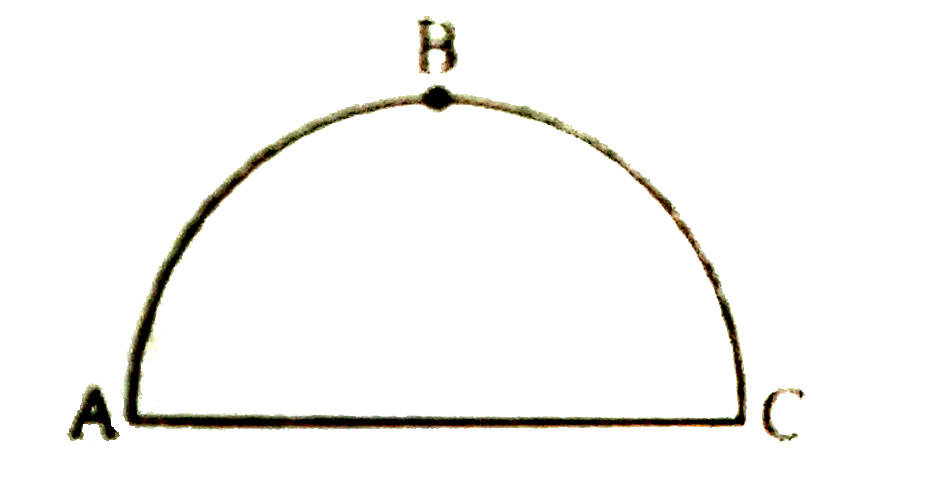A particle of mass 10 g moves along a circle of radius 6.4 cm with a constant tangential acceleration. What is the magnitude of this acceleration. What is the magnitude of this acceleration, if the kinetic energy of the particle becomes equal to 8×10−4J by the end of the second revolution after the beginning of the motion?
0.15ms−2
0.18ms−2
0.2ms−2
0.1ms−2
The correct Answer is:D
To solve the problem, we need to find the magnitude of the tangential acceleration of a particle moving in a circular path, given its mass, radius, and kinetic energy after two revolutions.
1. Convert Units:
- The mass of the particle is given as 10 g. Convert this to kilograms:
m=10g=0.01kg
- The radius is given as 6.4 cm. Convert this to meters:
r=6.4cm=0.064m
2. Calculate the Distance for Two Revolutions:
- The distance covered in one revolution is given by the circumference of the circle:
Distance for one revolution=2πr
- Therefore, the distance for two revolutions is:
s=2×(2πr)=4πr
- Substituting the value of r:
s=4π(0.064)≈0.804m
3. Use Kinetic Energy to Find Final Velocity:
- The kinetic energy (KE) at the end of the second revolution is given as 8×10−4J. The formula for kinetic energy is:
KE=12mv2
- Rearranging this to find v2:
v2=2×KEm=2×(8×10−4)0.01
- Calculating v2:
v2=16×10−40.01=0.016m2/s2
4. Calculate Tangential Acceleration:
- We can use the equation of motion for tangential acceleration:
v2=u2+2as
- Since the particle starts from rest, u=0:
v2=2as
- Rearranging to find a:
a=v22s
- Substituting the values of v2 and s:
a=0.0162×0.804≈0.0161.608≈0.00994m/s2
5. Final Result:
- The magnitude of the tangential acceleration is approximately:
a≈0.01m/s2
- The mass of the particle is given as 10 g. Convert this to kilograms:
m=10g=0.01kg
- The radius is given as 6.4 cm. Convert this to meters:
r=6.4cm=0.064m
- The distance covered in one revolution is given by the circumference of the circle:
Distance for one revolution=2πr
- Therefore, the distance for two revolutions is:
s=2×(2πr)=4πr
- Substituting the value of r:
s=4π(0.064)≈0.804m
- The kinetic energy (KE) at the end of the second revolution is given as 8×10−4J. The formula for kinetic energy is:
KE=12mv2
- Rearranging this to find v2:
v2=2×KEm=2×(8×10−4)0.01
- Calculating v2:
v2=16×10−40.01=0.016m2/s2
- We can use the equation of motion for tangential acceleration:
v2=u2+2as
- Since the particle starts from rest, u=0:
v2=2as
- Rearranging to find a:
a=v22s
- Substituting the values of v2 and s:
a=0.0162×0.804≈0.0161.608≈0.00994m/s2
- The magnitude of the tangential acceleration is approximately:
a≈0.01m/s2
Topper's Solved these Questions
- CIRCULAR MOTIONBOOK - DC PANDEYCHAPTER - CIRCULAR MOTIONEXERCISE - Match the columns
3 Videos
- CENTRE OF MASS, LINEAR MOMENTUM AND COLLISIONBOOK - DC PANDEYCHAPTER - CENTRE OF MASS, LINEAR MOMENTUM AND COLLISIONEXERCISE - Level 2 Subjective
21 Videos
- COMMUNICATION SYSTEMBOOK - DC PANDEYCHAPTER - COMMUNICATION SYSTEMEXERCISE - Only One Option is Correct
27 Videos
Similar Questions
A particle of mass 10 g moves along a circle of the radius 1π cm with a constant tangential acceleration. What is the magnitude of this acceleration (in ms−1) if the kinetic nergy of the particle becomes equal to 8×10−4J by the end of the second revolution after the beginning of the motion? (Particle starts from rest)
View SolutionA particle of mass 10 g moves along a circle of radius 64 cm with a constant tangential acceleration. What is the magnitude of this acceleration if the kinetic energy of the particle becomes equal to 8×10−4J by the end of the second revolution after the beginning of the motion ?
View Solution
Knowledge Check
A paritcal of mass 10g moves along a circle of radius 6.4cm with a constant tangennitial acceleration. What is the magnitude of this acceleration . What is the magnitude of this acceleration if the kinetic energy of the partical becomes equal to 8×10−4J by the end of the second revolution after the beginning of the motion?
A0.2m/s2B0.1m/s2C0.15m/s2D0.18m/s2A particle of mass 10 g moves along a circle of radius 6.4 cm with a constant tangential acceleration. What is the magnitude of this acceleration if the kinetic energy of the particle becomes equal to 8×10−4J by the end of the second revolution after the beginning of the motion?
A0.18m/s2B0.2m/s2C0.1m/s2D0.15m/s2A particle of mass 10 g moves along a circle of radius 64 cm with a constant tangential acceleration. What is the magnitude of this acceleration if the kinetic energy of the particle becomes equal to 8×10−4J by the end of the second revolution after the beginning of the motion ?
A0.02m/s2B0.01m/s2C0.015m/s2D0.018m/s2
A particle moves in a circle of radius 2 m at a second
what is its resultant (total ) acceleration at time t=1 s ?
View SolutionIf a particle of mass m start from along curved circular path shown in figure with constant tangential acceleration a, then net force at B on the particle has the magnitude :

View SolutionA particle moves along a circle of radius 40π m with constant tangental acceleration. If the velocity of the particle is 100 m/s at the end of the 4th revolution after motion has begin, the tangential acceleration is
View SolutionA particle moves along a circle of radius r with constant tangential acceleration. If the velocity of the particle is v at the end of second revolution, after the revolution has started, then the tangential acceleration is
View SolutionA particle moves in a circle of radius 5 cm with constant speed and time period 0.2πs. The acceleration of the particle is
View Solution
